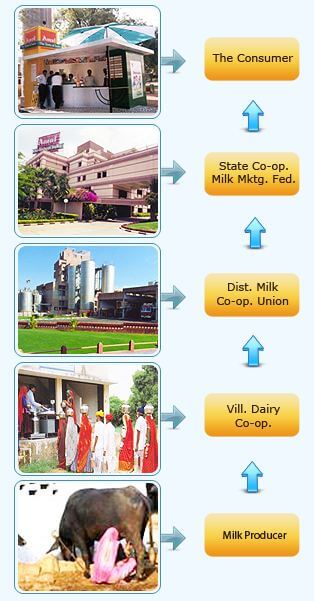In this article, You will read White Revolution in India for UPSC IAS.
White Revolution
- The package programme adopted to increase the production of milk is known as White Revolution in India, also known as Operation Flood.
- The White Revolution in India occurred in 1970, when the National Dairy Development Board (NDDB) was established to organize dairy development through cooperative societies. Prof. Verghese Kuerin was the father of white Revolution in India.
- The dairy development programme through cooperative societies was first established in the state of Gujarat. The cooperative societies were most successful in the Anand District of Gujarat. The cooperative societies are owned and managed by the milk producers.
- These cooperatives apart from financial help also provide consultancy. The increase in milk production has also been termed as operation Flood. Varghese Kurien (1921 – 2012) who is considered as the ‘Father of White Revolution in India’ was one of the world’s great agricultural leaders of the 20th century.
Objectives
- The main objectives of the cooperative society are the procurement, transportation, storage of milk at the chilling plants.
- To provide cattle feed.
- The production of wide varieties of milk products and their marketing management.
- The societies also provide superior breeds of cattle (cows and buffaloes), health services, veterinary, and artificial insemination facilities.
- To provide extension service.
- The technology of the White Revolution is based on an extensive system of cooperative societies.
- Milk after being collected at a village collection centre, is promptly transported to the dairy plant at the milk chilling centre.
- Timing of collection is maintained by the village society, truck operators, and the quick transport to the dairy plants.
- The chilling centres are managed by producer’s cooperative unions to facilitate the collection of milk from producers who live at some distance from the chilling centres and thus, the middlemen are eliminated.

Phases of the White Revolution
- The white Revolution may be examined under the following three phases:
- Phase I (1970 – 81)
- During this period, the Dairy Development Programme was set up in ten states to provide milk to the cosmopolitan cities, i.e. Mumbai, Kolkata, Delhi, and Chennai.
- Phase II (1981 – 85)
- During this phase, the dairy development programme was extended in the states of Karnataka, Madhya Pradesh, and Rajasthan. In this phase, within 25 contiguous milk shed areas [in 155 districts] a cluster of milk producers’ union was established. The Research Institute at Hyderabad developed a vaccine called ‘Raksha’ to control cattle diseases. The programme also involved the improvement in milk marketing in 144 more cities of the country. The Dairy Cooperative societies were set up in 35000 villages and the membership exceeded 36 lakhs.
- Phase III (1985 – 2000)
- A number of cooperative societies were set up in most of the major states of the country and the number of cooperatives went up by 1,35,439 with a membership of 14 million. The following table 9.16 shows the spurt in milk production in India.
- Phase I (1970 – 81)
The Phenomenal Increase in Milk Production in India – 1950–51 to 2005–06

Achievement
- White Revolution is as important to dairy development as Green Revolution has been to grain production. Its outcome is based on the improvement in cattle breeding and the adoption of new technology.
- Today, India has earned the first position in milk production in the world.
- Some of the important achievements of the White Revolution are as under:
- The White Revolution made a sound impact on rural masses and encouraged them to take up dairying as a subsidiary occupation.
- India has become the leading producer of milk in the world. The milk production that was about 17 million tonnes in 1950-51 rose to over 112 million tonnes in 2009-10. The production of milk has gone up by more than six times when compared with that of the Pre–Independence situation.
- The per capita availability of milk per day at present is about 263 gm as against 125 grams before the white Revolution.
- The import of milk and milk production has been reduced substantially.
- White Revolution is as important to dairy development as Green Revolution has been to gram production. Its outcome is based on the improvement in cattle breeding and the adoption of new technology.
- Today, India has earned the first position in milk production in the world.
- The small and marginal farmers and the landless labourers have been especially benefitted from the White Revolution. About 14 million farmers have been brought under the ambit of 1,35,439 village-level dairy cooperative societies.
- To ensure the success of the Operation Flood Program, research centres have been set up at Anand, Mehsana, and Palanpur (Banaskantha). Moreover, three regional centres are functioning at Siliguri, Jalandhar, and Erode.
- Livestock Insurance Scheme was approved in February 2006 and in 2006-07 on a pilot basis in 100 selected districts across the country. The scheme aims at protecting the farmers against losses due to the untimely death of animals.
- To improve the quality of livestock, extensive cross-breeding has been launched.
- For ensuring the maintenance of disease-free status, major health schemes have been initiated.
- The government implemented livestock insurance on a pilot basis in 2005-06.
Problems And Prospects
- Some of the important problems of the ‘white Revolution is as under.
- Collection of milk from remote areas is expensive, time-consuming, and not viable economically.
- In most of the villages, the cattle are kept under unhygienic conditions.
- There are inadequate marketing facilities. The marketing infrastructure needs much improvement.
- The breeds of cattle are generally inferior.
- The extension service programme is not effective.
